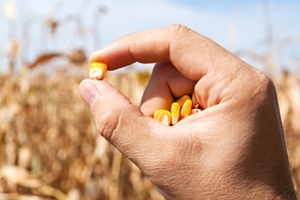2006, DOI: 10.1111/j.1365-3040.2005.01493.x
Can improvement in photosynthesis increase crop yields?
Abstract
 The yield potential (Y(p)) of a grain crop is the seed mass per unit ground area obtained under optimum growing conditions without weeds, pests and diseases. It is determined by the product of the available light energy and by the genetically determined properties: efficiency of light capture (epsilon(i)), the efficiency of conversion of the intercepted light into biomass (epsilon(c)) and the proportion of biomass partitioned into grain (eta). Plant breeding brings eta and epsilon(i) close to their theoretical maxima, leaving epsilon(c), primarily determined by photosynthesis, as the only remaining major prospect for improving Y(p). Leaf photosynthetic rate, however, is poorly correlated with yield when different genotypes of a crop species are compared. This led to the viewpoint that improvement of leaf photosynthesis has little value for improving Y(p). By contrast, the many recent experiments that compare the growth of a genotype in current and future projected elevated [CO(2)] environments show that increase in leaf photosynthesis is closely associated with similar increases in yield. Are there opportunities to achieve similar increases by genetic manipulation? Six potential routes of increasing epsilon(c) by improving photosynthetic efficiency were explored, ranging from altered canopy architecture to improved regeneration of the acceptor molecule for CO(2). Collectively, these changes could improve epsilon(c) and, therefore, Y(p) by c. 50%. Because some changes could be achieved by transgenic technology, the time of the development of commercial cultivars could be considerably less than by conventional breeding and potentially, within 10-15 years.
The yield potential (Y(p)) of a grain crop is the seed mass per unit ground area obtained under optimum growing conditions without weeds, pests and diseases. It is determined by the product of the available light energy and by the genetically determined properties: efficiency of light capture (epsilon(i)), the efficiency of conversion of the intercepted light into biomass (epsilon(c)) and the proportion of biomass partitioned into grain (eta). Plant breeding brings eta and epsilon(i) close to their theoretical maxima, leaving epsilon(c), primarily determined by photosynthesis, as the only remaining major prospect for improving Y(p). Leaf photosynthetic rate, however, is poorly correlated with yield when different genotypes of a crop species are compared. This led to the viewpoint that improvement of leaf photosynthesis has little value for improving Y(p). By contrast, the many recent experiments that compare the growth of a genotype in current and future projected elevated [CO(2)] environments show that increase in leaf photosynthesis is closely associated with similar increases in yield. Are there opportunities to achieve similar increases by genetic manipulation? Six potential routes of increasing epsilon(c) by improving photosynthetic efficiency were explored, ranging from altered canopy architecture to improved regeneration of the acceptor molecule for CO(2). Collectively, these changes could improve epsilon(c) and, therefore, Y(p) by c. 50%. Because some changes could be achieved by transgenic technology, the time of the development of commercial cultivars could be considerably less than by conventional breeding and potentially, within 10-15 years.
